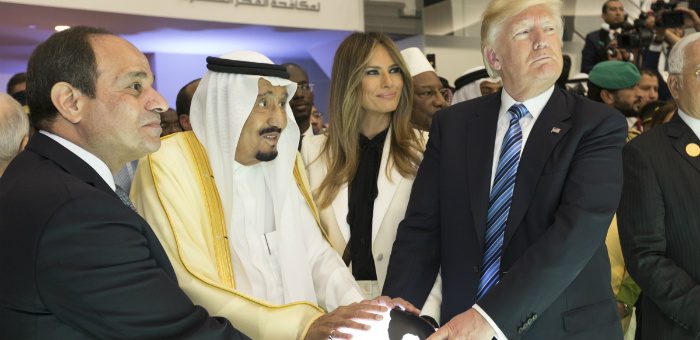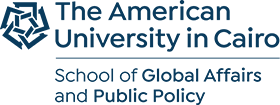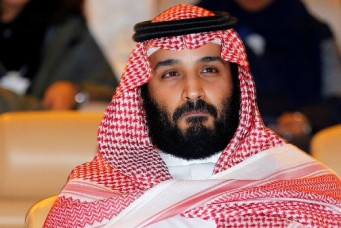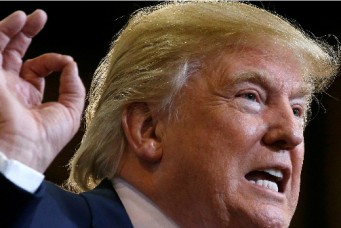Empty Promises in Riyadh
The Trump administration pageant moves to the Middle East.

Inaugural opening of the Global Center for Combating Extremist Ideology, Riyadh, May 21, 2017. Shealah Craighead/Official White House Photo
“When shall we three meet again, in thunder, lightning or in rain?”
The opening line from Macbeth is an irresistible comment to pin below the photo of King Salman Bin Abdelaziz Al-Saud, President Abdel Fattah El-Sisi, and President Donald Trump standing in semi darkness with their hands on a glowing globe representing the launch of Riyadh’s new center to combat global terrorism. While it offered Trump a chance to appear presidential and determined, the spectacle still left many questions unanswered. Among them: Is there a more benign method of combatting extremism in Trump’s policy grab-bag, given that $100 billion arms agreement with Saudi Arabia was signed but nothing was pledged to help with development in poor Arab countries? The space for a specific strategy for the new alliance against terrorism was left blank and, in a region brimming with human rights abuses, little was said to address the aspirations of youthful populations in the region still yearning for reform, except for the platitudes about living in peace once terror is defeated.
There is no doubt that Trump’s tour of Saudi Arabia, Israel, and the Vatican, as a first visit abroad for a new U.S. president, was full of symbolism. First, the choice of Islamic, Jewish, and Christian centers of worship (albeit with qualification in each case), was meant to reflect respect for the three main monotheistic religions in the world and to send a message of tolerance and coexistence among people of different faiths. Score one for Trump. Second, there was the deliberately different tone on terrorism, no longer the campaign theme of “Islam hates us,” but now a message of joint confrontation against the scourge of terror, which overwhelmingly “targets and harms the Arab and Muslim world.” Trump even seized the moment to show respect instead of contempt to the culture of his Arab host and Muslim audience. Another score for the U.S. president.
If the focus was on feel-good themes and solidarity in the face of a common threat, the good versus evil banner was a touch too melodramatic and rather void of realistic strategies. There were no follow-up sessions among foreign ministers and security specialists of the convening nations; it is doubtful U.S. diplomats will follow up with participants in the months ahead, for the simple reason that the Trump administration has left the State Department short staffed. The press statements and conference between Secretary of State Rex Tillerson and Saudi Foreign Minister Adel Al-Jubeir did specify what would be included in a bilateral deal and how collaboration between the two nations would be enhanced in military, intelligence, and regional vigilance.
There has been no official mention of the concept of an “Arab NATO.” But some Arab media, enthusiastic about Saudi Deputy Crown Prince Mohammed Bin Salman Bin Abdelaziz’s injection of a new aggressiveness in both speech and action in the region, have dubbed the Riyadh summit as exactly that. They see the chance to create a military alliance among like minded nations in the Arab and Islamic world supported by a new alliance with the United States. Riyadh has been trying to lead exactly this kind of a coalition in its war against the Houthis in Yemen. The problem is that key countries in the region—Egypt, Jordan, and Morocco, not to mention Pakistan—have been reluctant to participate directly in this war and lend their land armies to the Saudi effort to roll back the Houthis. Furthermore, the Riyadh summit appeared exclusively a Sunni gathering with the potential lone Shia leader, Prime Minister Haider Al-Abadi of Iraq, staying away and sending Iraq’s Sunni president and defense minister instead.
Another problematic aspect of this would-be pact is its focus on military readiness and security, ostensibly so “new generations could live in peace.” Trump and King Salman’s keynote speeches, however, were devoid of any real concern for the tired, the hungry, and the oppressed in the Arab-Islamic world. While there was much reference during and after the summit to the $100 billion arms deal, there was no mention of an equally magnanimous fund for development. And, even though lip service was offered to diplomacy, there was scarcely a mention of any new diplomatic initiatives to end the conflict in Yemen and turn the Saudi-American bombs deployed there into ploughshares. In the Tillerson-Jubeir press conference, the principals’ references to Iran being the source of instability in the region were reiterated and Tillerson’s stated preference for a diplomatic solution to the Yemen crisis was qualified with, “however, we are also aware of the need to use force to bring the rebels to the table.” While he said that he would never shut his phone off to anybody wishing to talk, he ruled out initiating any new dialogue with Iran.
The spread of famine, cholera, and dying children in Yemen stood in macabre contrast to the opulence of the room in which summiteers met. Their speechifying did not include any specifics on how this new coalition of the willing would counter Russia, Iran, and the Bashar Al-Assad regime in the Syria conflict. Ironically, Iran had just concluded a national election as the Riyadh summit convened—an election which renewed Iranians’ preference for moderate President Hassan Rouhani over hardline cleric Ebrahim Raisi. There was nary a nod in the direction of Iran’s moderates to acknowledge and perhaps lend some support to that trend inside the country.
Some Saudi commentators have spoken prematurely of a Trump Doctrine in the Middle East. To the extent we may be witnessing the emergence of one, the Trump administration is branding the main conflict in the Middle East as one of good versus evil and aiming to unify the former against the latter. This has all the markings of another “let’s a build a wall” idea: one that doesn’t go beyond the surface problem of terrorism to the causes that run deep below it, and one that doesn’t allocate enough resources for diplomacy in search of solutions for the lingering conflicts in the region. And, speaking of resources, one might add that funding this wall might be even more problematic than allocating the resources for the real wall back home on the American-Mexican border.
Nabeel Khoury is non-resident senior fellow with the Rafik Hariri Center for the Middle East at the Atlantic Council. On Twitter: @khoury_nabeel.




